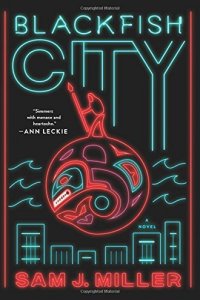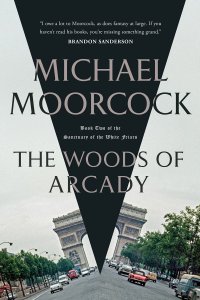Paul Di Filippo Reviews Blackfish City by Sam J. Miller
Blackfish City, Sam J. Miller (Ecco 978-0-06-268482-0, $22.99, 336pp, hardcover) April 2018
 I’m going to confess to an idiosyncratic critical weakness: if you want me to be immediately predisposed towards your novel, preface it with an epigram from Dhalgren. Not only will I instantly respect your taste and cultural leanings, but I will be excited to see if your own book can possibly be worthy of bearing such an imprimatur. Of course, this trick does not work if there is a huge dissonance between epigram and text regarding quality and goals, so be careful!
I’m going to confess to an idiosyncratic critical weakness: if you want me to be immediately predisposed towards your novel, preface it with an epigram from Dhalgren. Not only will I instantly respect your taste and cultural leanings, but I will be excited to see if your own book can possibly be worthy of bearing such an imprimatur. Of course, this trick does not work if there is a huge dissonance between epigram and text regarding quality and goals, so be careful!
In line with this aesthetic prejudice, when I opened Sam Miller’s first book for a non-YA audience (his actual debut novel was The Art of Starving from 2017) and saw the lines from Delany’s masterpiece–a little passage relating to the nature of Bellona, that surreal, gritty city of Delany’s imagination–I was keen to learn if Miller’s own book had the same kind of emotional resonance, conceptual inventiveness and intellectual heft as Dhalgren. I am chuffed to report that Blackfish City is a worthy descendant of Dhalgren. While it deliberately does not intend to ape its ancestor, having different goals in mind, it shares a spiritual kinship with that illustrious forerunner. And in fact, as I will try to show, it arises out of a little corner of the same New Wave soil that birthed Dhalgren.
Our setting is, I believe, the early 2100s. Viz: “If the twentieth century was shaped by warring ideologies, and the twenty-first was a battle of digital languages, our present age is defined by dueling approaches to oceanic city engineering…” Climate change has wreaked utter havoc everywhere, along well-imagined lines. Fallen governments, new diseases, hordes of refugees, barbarism. One partial, multiplex exception to this chaos is the contructed polar city of Qaanaaq.
Qaanaaq is an eight-armed asterisk. East of Greenland, north of Iceland. Built by an unruly alignment of Thai-Chinese-Swedish corporations and government entities, part of the second wave of grid city construction, learning from the spectacular failures of several early efforts. Almost a million people call it home…
One might immediately think of Jean-Christophe Valtat’s fabulous Aurorarama and its sequel, Luminous Chaos, which posit a similar frozen milieu. But those books are Helprinesque fables, whereas Miller’s novel is pure Bacigalupi-Buckell-KS Robinson societal catastrophism.
We quickly learn that our narrative will be fruitfully splintered into multiple viewpoints, coming at us from various strata of society in fast-moving, punchy installments. These shared narrative voices and utterly naturalistic presentation immediately distinguish the book from the Kid-centric primacy of Dhalgren and that book’s impressionistic, oneiric tactics. The main point of commonality between Miller and Delany thus becomes the sense of the city as a shaping force on its inhabitants. Secondarily shared is a sense of the interdependency of the variegated citizens, and how paths and destinies cross.
Here are our protagonists:
Fill Podlove, a young gay hooker whose rich grandfather Martin is a mover and shaker with an infamous past. Fill has contracted a terminal STD, “the breaks,” which is going to lead to strange mental and physical phenomena before death.
Ankit Bahawalanzai, an employee on the staff of Arm Manager Fyodorovna. With her boss looking to lose her position in the next election, Ankit also faces an uncertain future, compounded by the fact that her almost-unfamiliar mother, Ora, has been committed for decades to an asylum, the Cabinet, for possibly political reasons. An important contact of Ankit’s is an old man named Ishmael Barron, who seems to have certain insights into the breaks disease.
Kaev, an athlete-brawler in the city’s essential game of beam-fighting, and unacknowledged brother to Ankit. Aging out of the tough sport, Kaev is coming to rely more on his connections with the female crimelord named Go.
Soq, a messenger on the Arm’s powered slideways, who is also being recruited by Go.
Additionally, we have offstage the figure or figures who lurk behind the media platform known as City Without a Map, a kind of podcast-cum-newspaper-cum-blog that charts Qaanaaq’s fevers.
And finally we must reckon with the Blackfish Woman, Masaaraq the orcamancer, a strange immigrant who appears out of nowhere, accompanied by a whale and a captive polar bear. (A nod to Philip Pullman perhaps?) Uncommunicative and dangerous–she is rumored to have left a trail of slaughter behind her–the woman constitutes an enigma that might destabilize the whole software-driven autonomous city. Why is she here, and who is the object of her vengeance?
Weaving these threads together with suspense and surprises, Miller eventually crafts a complex tapestry of betrayal and allegiances, debts and paybacks. The personal issues of these citizens, working their way to equilibrium, will come to have a nigh-apocalyptic effect on the city itself.
Ultimately, the novel’s main theme is family. “Soq had an inkling of the vast and terrifying tangle of expectations and obligations and pain and bliss that lay hidden in the word family.” In a world where larger groupings and infrastructures and organizations have gone belly-up, family is the essential foundation from which one rebuilds. And Miller extends the notion of family with the concept of nanobonding, integration of human and animal consciousnesses through nanotech. (A bit of resonance with Lauren Beukes’s Zoo City here, as well as the aforementioned Pullman nod.)
Although paradigm-shattering events do occur in Blackfish City, this book seems to me essentially akin to the kind of ashcan-realism, sociological novels that were once a fundamental corner of the New Wave. I am thinking of books such as Disch’s 334; Brunner’s Stand on Zanzibar; and Spinrad’s Bug Jack Barron. (Hinted at by Miller’s choice of a certain surname?) These books did not center on lone wolf Heinleinian heroes engaged in save-the-universe or overthrow-the-tyranny quests, but rather on multilevel slice-of-life depictions of our future, often with open-ended resolutions. Michael Bishop carried the mode onward with his Urban Nucleus sequence set in a future Atlanta, and Maureen McHugh’s China Mountain Zhang brought the mode into the 1990s. But this kind of SF novel has fallen out of favor since then, subsumed by larger-than-life heroics, and it’s heartening to think that a new generation of writers might be picking up the baton and limning our possible futures in a manner that does not depend of all-or-nothing, earth-shattering conflicts.
 While you are here, please take a moment to support Locus with a one-time or recurring donation. We rely on reader donations to keep the magazine and site going, and would like to keep the site paywall free, but WE NEED YOUR FINANCIAL SUPPORT to continue quality coverage of the science fiction and fantasy field.
While you are here, please take a moment to support Locus with a one-time or recurring donation. We rely on reader donations to keep the magazine and site going, and would like to keep the site paywall free, but WE NEED YOUR FINANCIAL SUPPORT to continue quality coverage of the science fiction and fantasy field.







